Research - (2022) Volume 12, Issue 8
Conservation of Balanites aegyptiaca var. aegyptiaca Del. in Algerian Sahara
C. Selkh1*, S. Bissati2, A. Chehma2 and M. Ould Safi3Abstract
We have studied the conservation through the domestication of the desert medicinal tree Balanites aegyptiaca var. aegyptiaca Del., in its natural environment in Adrar (Algerian Sahara). For this purpose, two techniques were tested: direct sowing and transplanting. Field observations have shown that the survival rate of individuals was important for the direct seeding technique in comparison to transplantation, with a percentage of 65% and 16.66% respectively. The study of a six-year-old Balanites aegyptiaca var. aegyptiaca plantation has shown that the best quality of the fruit production was found at 57.14% of Balanites individuals presented by a common phenotype with trees characterized by a high density of leaves and thorns. Two other phenotypes produced fruits of lower quality: 21.42% of individuals with long thorns, and 14.28% with short leaves, respectively. This study allowed us to observe the possibility of the domestication of Balanites aegyptiaca var. aegyptiaca Del. It gives good fruit productivity; in addition, its water requirements are low for agriculture in drylands. The study has also shown that the tree of Balanites aegyptiaca var. aegyptiaca Del., is interesting to use in sustainable agriculture in the hyper arid areas.
Keywords
Balanites aegyptiaca var. aegyptiaca Del., Conservation, Drylands, Phenology, Algerian Sahara
Introduction
Nowadays the Saharan flora is regressing in its area due to global warming and human activity, this has been cited by several scientific studies as: (Le Berre and Ramousse, 2003; Rognon, 2007; Selkh, 2012). AA simple comparison between the studies of the last century such as: Guinet (1954), Guinochet and Quezel (1954), Barry et al., (1985), and our recent observations in the field are sufficient to understand the magnitude of this regression.
In Adrar, in the Algerian Sahara, a specific tree attracted our attention: it's Balanites aegyptiaca var. aegyptiaca Del., commonly known as the desert date tree. This tree is typical of the hyper-arid regions of the Sahara, unlike the other varieties of Balanites aegyptiaca mentioned. A small, isolated stand of this tree is found in Adrar, Algeria, at 27°N latitude and 0° longitude. The largest and closest population of this tree is in the Hoggar Mountains, over 500 km in a direct line south of Adrar. This tree is used in traditional medicine by the indigenous population of the Sahara and as food supplement by the nomads.
From a purely botanical point of view, Balanites aegyptiaca var. aegyptiaca Del., is a tree of the Zygophyllaceae family. It is very branched and thorny with bi-leaflet leaves about 5 cm long and 4 cm wide, and ovoid fruits 3-4 cm long, greenish during ripening and light yellow at maturity. According to Quezel (1965), Ozenda (1977) and Arbonnier (2000), this tree can reach 8 m high. Its northernmost limit in the Sahara is at latitude 27°N, where only a few examples of this species can still be found at Adrar, Algeria (Fig. 1). Balanites aegyptiaca var. aegyptiaca Del., which characterizes the hyper-arid regions of the Sahara, should not be confused with other varieties described in other regions in Africa or desert Asia (Tela-Botanica n.d.; CJB n.d.; Hall et al., 1991; Bassimbe-Sagna et al., 2014).
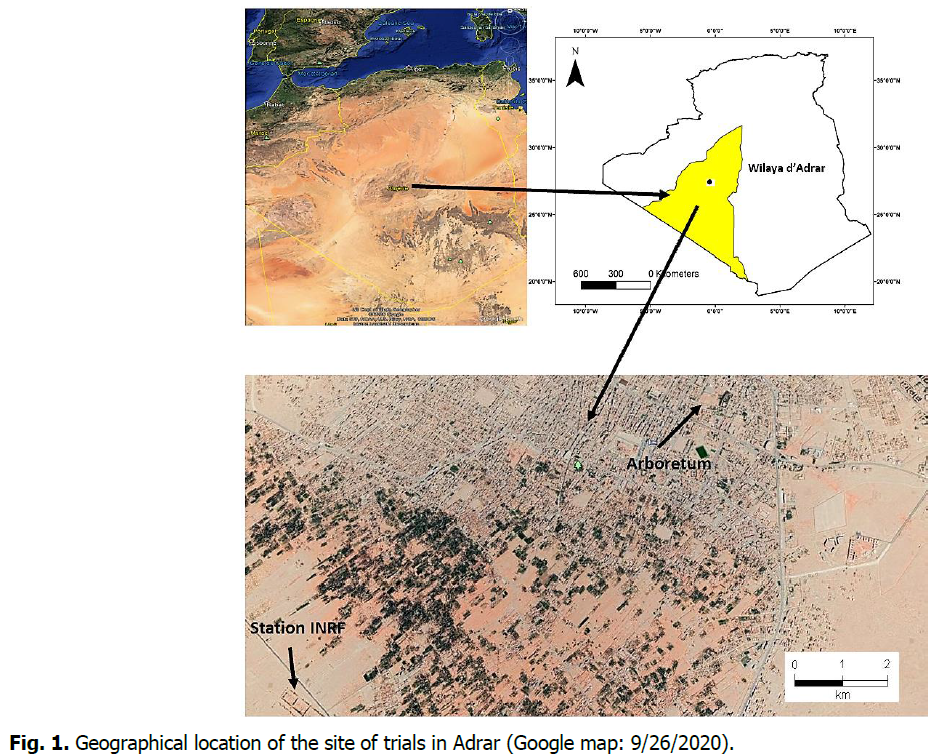
Fig 1: Geographical location of the site of trials in Adrar (Google map: 9/26/2020).
The safeguarding of Balanites aegyptiaca var. aegyptiaca, in its environment in Adrar is impossible due toto climate change observed with a decrease in rainfall, and an increase in evapotranspiration which further aggravates the desert conditions. To conserve this species, we made a domestication trial over six years in the Saharan station of the National Institute of Forest Research (I.N.R.F) in Adrar, Algeria as shown in Fig. 1, an approach already experienced in other deserts around the world such as Israel (Shelef et al., 2016).
Materials and Methods
The seeds of Balanites aegyptiaca var. aegyptiaca Del., were harvested in April 2013 in a valley in Matriouene (27.48.00°N, 1.19.59°E) located in the south of the wilaya of Adrar (Fig. 1), then sowed in October 2013 in the forest conservation nursery of the city of Adrar (27.52.37°N, 0.16.45°W). After five months of breeding, about twenty seedlings were planted in February 2014 in the arboretum located near the nursery mentioned above. The irrigation technique adopted is dripping as for fruit trees, with a variation of the schedule according to the season and this throughout the duration of the experiment until the end of 2019 (more than six years). In parallel, a complementary study was carried out in the Adrar National Institute of Forest Research (I.N.R.F: 27.50.50°N, 0.18.30°W) to know the best technique of the installation of Balanites aegyptiaca var. aegyptiaca, by direct sowing or transplantation.
For the realization of this work, we used:
•A forest compass to measure the diameter of trees.
•A Blum-leiss dendrometer to measure the height of trees.
•An ordinary tape meter.
• A caliper to measure the average length, mass and width of fruits, leaves and thorns on several young twigs of 20 cm chosen at random for each tree.
•A precision balance with a sensitivity of 0.001 g, to measure the mass of fruits, leaves, and thorns.
•A Garmin-branded GPS.
To be able to understand and interpret the nature of the phenotypic groupings resulting from this experiment we used statistical analyses of the ascending hierarchical classification (HCA) and the analysis of the main components (PCA), using the Xlstat 2020 software.
Bioclimate of the Adrar station
To clarify the specific bioclimatic characteristics of the settlement of Balanites aegyptiaca var. aegyptiaca in the Adrar region in comparison to other deserts around the world, we conducted a bioclimatic synthesis of climatic data provided by Algeria's National Office of Meteorology from 1989 to 2019. The climate study was concentrated on two issues:
• The climate of Adrar.
• The United Nations Environment Program's (UNEP) aridity index to understand how evapotranspiration and precipitation affect biodiversity.
The Climate in Adrar region
The Adrar region, where we are conducting our research, only gets 16 mm of rain annually. In contrast to the typical humid environment shown in Fig. 2, the air is so dry and clear that it transfers all of the available sunlight to the ground, causing the temperature to shift dramatically from low in winter to very hot in summer.
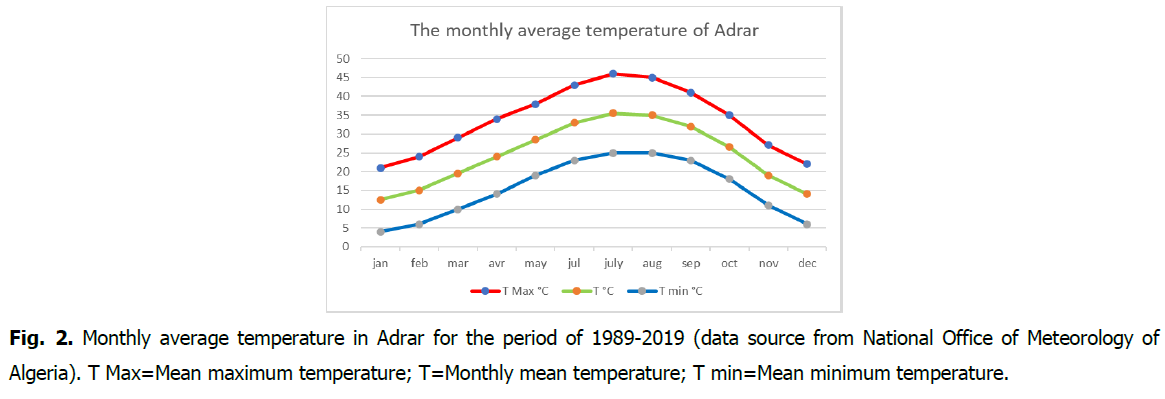
Fig 2: Monthly average temperature in Adrar for the period of 1989-2019 (data source from National Office of Meteorology of Algeria). T Max=Mean maximum temperature; T=Monthly mean temperature; T min=Mean minimum temperature.
In addition to receiving little rainfall, the Adrar region experiences significant rates of evapotranspiration from the soil and vegetation. The Algerian desert biomes are among the driest on the planet, as seen in Fig. 3, where the rate of evapotranspiration approximates a ratio of 160:1 or more to the average annual rainfall.
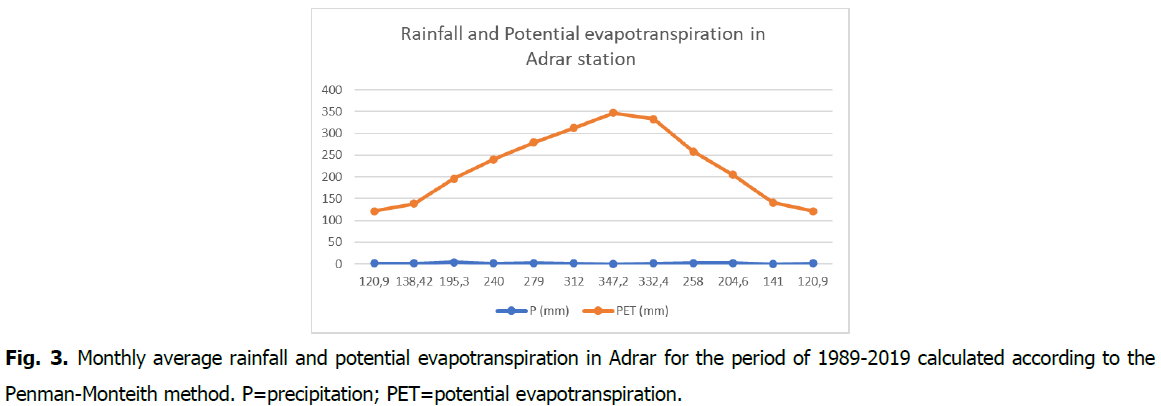
Fig 3: Monthly average rainfall and potential evapotranspiration in Adrar for the period of 1989-2019 calculated according to the Penman-Monteith method. P=precipitation; PET=potential evapotranspiration.
The aridity index
The aridity index (A.I) of the United Nations Environment Program (in Ward 2009) makes it possible to know the degree of aridity of a climate (Table 1), using this formula AI=P/PET, where P is the annual average of precipitation and PET is the annual Potential Evapotranspiration calculated according to the Penman-Monteith method as seen in Fig. 3.
| Classification | aridity index | the world's land surface |
|---|---|---|
| Hyperarid | AI<0.05 | 7.5% |
| Arid | 0.05<IA<0.20 | 12.1% |
| Semi-arid | 0.20<IA<0.50 | From 17.7% |
| Dry Sub-humid | 0.50<IA<0.65 | From 9.9% |
Table 1. Aridity index according to P. N.U.E method.
The bioclimatic synthesis of Adrar area shows that this region is characterized by a warm hyper-arid climate almost during all the year, and a short winter with little rainfall which is enable to compensate the strong evapotranspiration of the area (Fig. 3), this is confirmed by the United Nations Aridity Index AI=0,016 ≤ 0,05 which indicates that Adrar is one of the driest regions in the world.
Statistical study of the phenotypic variability of Balanites tree
The planting of Balanites aegyptiaca var. aegyptiaca, was followed over more than six years from the date of its planting in October 2013 until the end of 2019. During growth fifteen successful individuals were followed by focusing on phenology, and the morphometric parameters presented in the chapter materials and methods part. In this statistical study the tree n°:2 was temporarily excluded from the analysis because it did not produce fruits during the year of the end of study.
Descriptive statistic
We proceeded to a descriptive statistic of the morphological data of the trees planted in Adrar station. Descriptive statistics are broken down into measures of central tendency and measures of variability (spread). Measures of central tendency include the mean, median, and mode, while measures of variability include standard deviation, variance, minimum and maximum variables, kurtosis, and skewness. The results of the descriptive statistics presented in the results and discussions section (Adam Hayes, 2022). We performed descriptive statistics using Xlstat 2020 software.
Hierarchical cluster analysis (H.C.A)
Hierarchical cluster analysis (H.C.A) consists of gradually aggregating individuals (observations) according to their resemblance which is measured using an index of similarity or dissimilarity (Meddour, 2010).
Principal component analysis (P.C.A)
In our study, main component analysis (PCA) is used to identify the traits that have the greatest influence on fruit quality variation. The principal component analysis (PCA) is a classical tool to reduce the dimension of expression data, to visualize the similarities between the biological samples, and to filter noise (Yao, F., Coquery, J. and Lê Cao, Ka 2012).
Study of the installation of Balanites
This experimental step aimed to compare the effectiveness of two Balanites installation techniques: direct sowing and transplanting. It has begun in April 2019 at the experimental station of the National Institute of Forest Research (I.N.R.F) in Adrar. We harvested 120 seeds from 14 six-year-old individuals planted in Adrar nursery and installed as follows:
• 60 seeds were sown directly on a 300 m line with 5 m between seeds on the line.
• At the same time, 60 seeds were seeded in the nursery and raised for six months, then transplanted to a line of 300 m near the line of direct sowing, with 5 m between lines.
For irrigation, we have applied the furrow irrigation method. In June 2020, after 15 months of growth, we randomly selected 10 individuals from the 60 direct sowing plants and 10 individuals from the 60 plants of transplantation to do a comparative phenological study later.
Results and Discussion
Balanites aegyptiaca var. aegyptiaca, is a thermophilic and xerophilic tree that has a great adaptation to extreme desert conditions. It is believed that currently its existence in its extreme northern limit to the Sahara is threatened by global warming, which manifests itself in the form of a lack of rainfall and an increase in potential evapotranspiration, which makes it uncertain to save this species in its natural environment, and that's why we used the domestication conservation approach to try to save this species as illustrated in Fig. 4.
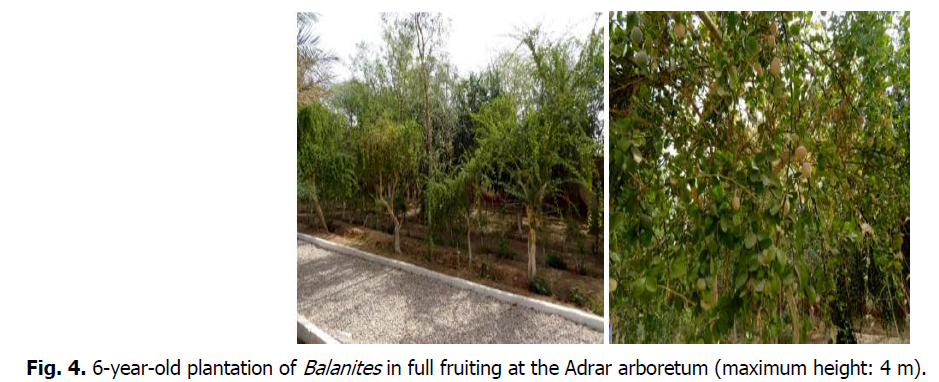
Fig 4: 6-year-old plantation of Balanites in full fruiting at the Adrar arboretum (maximum height: 4 m).
As shown in research by Shelef Oren et al., (2016) (2016), Israelis were among the first to experience the domestication of spontaneous desert plants. In our work, we have emphasized the quality of the fruits obtained from domesticated desert plants, especially the Balanites.
Statistical study of the phenotypic variability of planted Balanites trees
In this study, phenotypic differences were observed between individuals despite the same provenance, the same sowing date, the same planting date, and the same growing conditions as shown in Table 2.
| Tree | Tree height (m) | Crown diameter (m) | Trunk diameter (m) | Thorns length (cm) | Thorns mass (g) | Thorns density | Leaves length (cm) | Leaves width (cm) | Leaves mass (g) | Leaves density | Fruits length (cm) | Fruits width (cm). | Fruits mass (g) |
|---|---|---|---|---|---|---|---|---|---|---|---|---|---|
| 1 | 3.6 | 4 | 10.9 | 4.15 | 0.114 | 16 | 2.83 | 2.04 | 0.27 | 35 | 2.2 | 1.87 | 3.967 |
| 2 | 5.1 | 2.8 | 8.5 | 4.99 | 0.262 | 18 | 3.88 | 3.59 | 0.308 | 54 | - | - | - |
| 3 | 2.3 | 2.3 | 4.5 | 3.63 | 0.591 | 18 | 3.21 | 2.11 | 0.164 | 60 | 2.42 | 1.87 | 3.167 |
| 4 | 4.3 | 2.8 | 5.8 | 1.9 | 0.215 | 24 | 2.56 | 1.83 | 0.113 | 40 | 2.72 | 1.83 | 4.07 |
| 5 | 5.2 | 3.9 | 8.9 | 3.01 | 1.031 | 17 | 3.3 | 2.52 | 0.208 | 49 | 2.43 | 1.99 | 4.375 |
| 6 | 7.3 | 5.4 | 6.5 | 6 | 0.213 | 16 | 3.43 | 2.68 | 0.229 | 54 | 2.43 | 1.95 | 4.375 |
| 7 | 6.7 | 4.5 | 6.4 | 2.59 | 0.078 | 19 | 4.35 | 2.71 | 0.304 | 56 | 2.43 | 1.95 | 4.238 |
| 8 | 7.5 | 5.3 | 6.8 | 5.02 | 0.145 | 26 | 3.76 | 3.07 | 0.344 | 60 | 2.42 | 1.59 | 3.192 |
| 9 | 7.1 | 5.5 | 5 | 4.07 | 0.174 | 18 | 4.29 | 3.01 | 0.325 | 54 | 2.98 | 2.06 | 4.864 |
| 10 | 6.9 | 4 | 11.5 | 6.38 | 0.173 | 19 | 3.19 | 2.46 | 0.233 | 41 | 2.41 | 1.93 | 3.358 |
| 11 | 3.5 | 3.5 | 4 | 6.11 | 0.314 | 14 | 3.02 | 2.5 | 0.234 | 27 | 2.19 | 1.78 | 2.907 |
| 12 | 6.5 | 5.6 | 11.6 | 3.18 | 0.114 | 14 | 3.67 | 2.84 | 0.339 | 55 | 2.8 | 1.98 | 5.275 |
| 13 | 5.5 | 5.8 | 11 | 6.56 | 0.424 | 15 | 3.59 | 3.01 | 0.296 | 31 | 2.7 | 1.764 | 3.305 |
| 14 | 5 | 3 | 7.1 | 4.38 | 0.242 | 7 | 2.92 | 2.13 | 0.133 | 22 | 2.31 | 1.6 | 2.699 |
| 15 | 3.2 | 3.1 | 5.2 | 4.46 | 0.147 | 8 | 3.62 | 2.38 | 0.275 | 30 | 2.44 | 1.74 | 3.675 |
Table 2. Mean of the measured morphological parameters measured on a 6-year-old plantation of Balanites aegyptiaca var. aegyptiaca, at the Adrar arboretum.
Descriptive statistics
Using the Xlstat 2020 program, the descriptive statistics for the morphological characteristics of Balanites trees planted at Adrar station are carried out, as shown in Fig. 5. The Descriptive statistics is the first step of data analysis (Himel Mondal et al., 2022). The analysis's findings revealed that the spine masses (red) and fruit lengths (green) had the most notable standard deviations from the median.
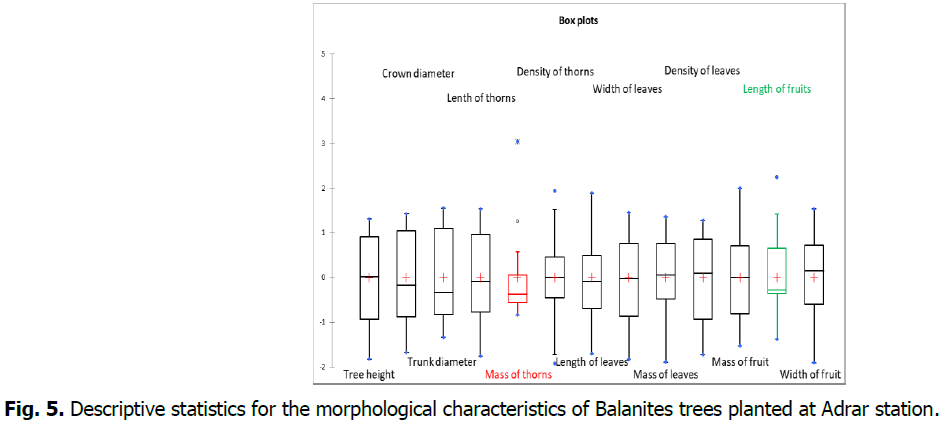
Fig 5: Descriptive statistics for the morphological characteristics of Balanites trees planted at Adrar station.
Hierarchical cluster analysis (H.C.A)
The hierarchical cluster analysis (H.C.A) shows that the remaining individuals are found in small motley groups and that 57.14% of the 14 Balanites trees that were seen share a common phenotype as seen in Fig. 6.
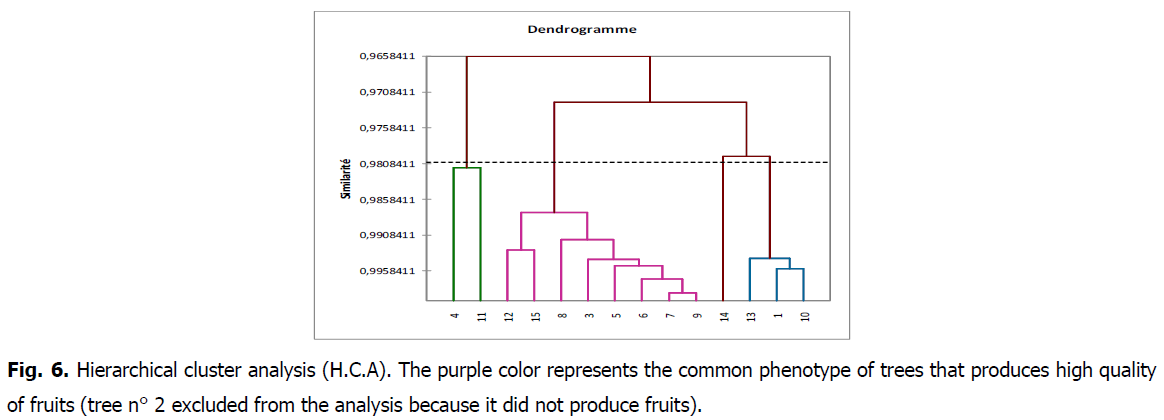
Fig 6: Hierarchical cluster analysis (H.C.A). The purple color represents the common phenotype of trees that produces high quality of fruits (tree n° 2 excluded from the analysis because it did not produce fruits).
Analysis of the principal components (P.C.A)
Finally, as shown in Fig. 7, the results of the principal component analysis (P.C.A.) of 14 observed trees reveal that the first two axes-40.02% on the F1 axis and 18.36% on the F2 axis-respectively account for 58.37% of the total inertia.
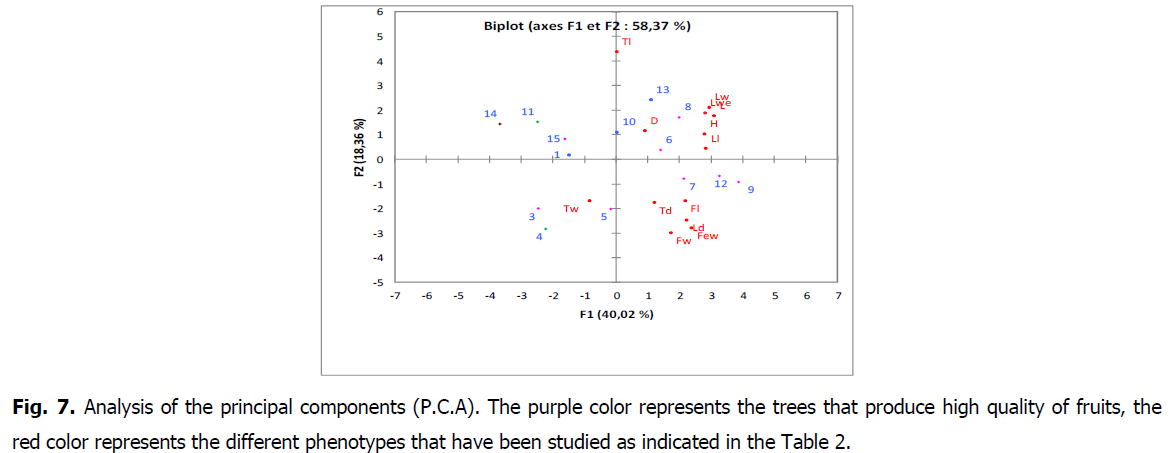
Fig 7: Analysis of the principal components (P.C.A). The purple color represents the trees that produce high quality of fruits, the red color represents the different phenotypes that have been studied as indicated in the Table 2.
The P.C.A demonstrates that on the F1 axis, there is an inverse relationship between the mass of thorns on the negative part of the axis and the good quality of the fruits (length, mass, and width) on the positive part of the axis; meanwhile, on the F2 axis, there is an inverse relationship between the quality of fruits and the density of thorns and leaves, as well as the length of thorns and leaf biomass (length, mass, width).
We may infer from the descriptive statistics, HCA, and PCA data that 57.14% of the Balanites individuals producing high-quality fruits have a similar phenotype, which is represented by trees with a lot of thorns and leaves. The other phenotypes seen, such as a first group of 21.42% of individuals with huge trunks and long thorns (almost 7 cm), and a second group of 14.28% of individuals with short leaves, produce fruits of lesser quality. The remaining people do not clearly fit into any phenotypic groups.
The installation of Balanites
For the first six months of the trial installation of Balanites aegyptiaca var. aegyptiaca, results have shown for direct sowing a success of 65% with a mortality of 35%. Therefore, for the individuals of transplantation, the success is only 16,.66% with a mortality of 93.33%. Good growth in height with well branching was observed in individuals from direct seedlings in opposite to transplanted individuals. It should be noted that these phenological differences have been observed for individuals with the same origin and installed under the same experimental conditions such as: soil type, sunshine, irrigation by flooding rays, which excludes the influence of physical factors in the environment.
As seen in Fig. 8, for the first six months of the trial installation of Balanites, results have shown for the individuals who have been direct sown a success of 65% with a mortality of 35%. For the individuals who have been transplanted, the success rate is only 16.66% with a mortality rate of 93.33%.
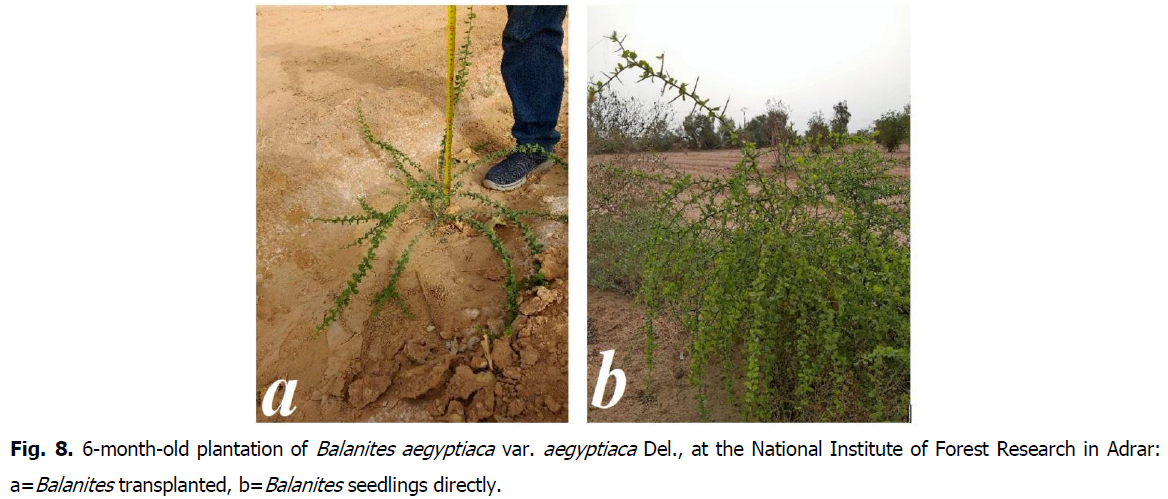
Fig 8: 6-month-old plantation of Balanites aegyptiaca var. aegyptiaca Del., at the National Institute of Forest Research in Adrar: a=Balanites transplanted, b=Balanites seedlings directly.
As shown in Table 3, during the experiment of the Balanites establishment, we observed high success in direct sowing individuals and low success in transplantation individuals, as well as strong height growth and good branching in direct sowing individuals. While transplanted individuals showed little development and branching.
| Tree | Transplanting | Direct sowing | ||||
|---|---|---|---|---|---|---|
| No | height (cm) | width (cm) | ramifications | height (cm) | width (cm) | ramifications |
| 1 | 30 | 30 | 1 | 90 | 120 | 37 |
| 2 | 56 | 97 | 14 | 28 | 73 | 7 |
| 3 | 17 | 5 | 1 | 55 | 97 | 26 |
| 4 | 17 | 5 | 1 | 83 | 85 | 11 |
| 5 | 40 | 63 | 11 | 77 | 110 | 55 |
| 6 | 22 | 3 | 1 | 29 | 34 | 5 |
| 7 | 20 | 50 | 5 | 54 | 95 | 13 |
| 8 | 90 | 100 | 21 | 25 | 80 | 8 |
| 9 | 80 | 98 | 55 | 22 | 10 | 2 |
| 10 | 80 | 27 | 16 | 43 | 58 | 8 |
Table 3. Phenological data of transplantation and direct sowing individuals of Balanites randomly chosen in Adrar nursery, Algerian Sahara.
These phenological differences have been observed for individuals with the same origin and installed under the same experimental conditions such as: soil type, sunshine, irrigation by flooding rays, ... which excludes the influence of physical factors in the environment. We could not elucidate the cause or factors of these observed differences despite the fact that the conditions of the experiment were similar.
Conclusion
Balanites aegyptiaca var. aegyptiaca, also known as the desert date tree, is a Saharan spontaneous tree with only a few specimens remaining in Algeria's northern Sahara. At present, it is so threatened by the change of its environment in the form of global warming, the drawdown of rain, and human activity that its future in the Adrar region is uncertain. Safeguarding work is necessary for this Saharan species, and it is for this reason we have carried out a conservation trial by domestication for more than six years, with encouraging results.
During this work of domestication of Balanites we found three different phenotypic groups where the most important was represented by 57.14% of the individuals who produce fruits with good quality. We hope that a selection work in this direction will continue for all large-scale planting of this tree, and for the best establishment of Balanites aegyptiaca var. aegyptiaca, we recommend to use direct sowing. We recommend that further work continues to enhance this interesting Saharan species, given its food, medicinal, economic and ecological qualities as well as its low water needs.
Our results on these trials are very encouraging and can be exploited in agriculture in arid or hyperarid areas. Indeed, the results showed that a better production of good quality fruits was observed mainly in individuals characterized by a high density of leaves and thorns. And at the same time, for the installation of Balanites, we observed high success in direct sowing individuals and low success in transplantation individuals. We believe that in the future this phenotype should be favored in possible large-scale plantings, especially if vegetative propagation is possible to ensure the genetic conformity of the plants produced. And our results may be applied everywhere in Saharan agriculture, especially as an income supplement for farmers in the context of sustainable development.
Acknowledgement
This work would not have been possible without the technical support of the station of the National Institute of Forestry Research (I.N.R.F) in Adrar and the laboratory of the National Institute of Agronomy research (I.N.R.A) in Adrar, I am especially indebted to Mr. Kharsi from I.N.R.A for his full technical support to perfect this research.
References
Arbonnier, M. (2000). Arbres, arbustes et lianes des zones sèches d'Afrique de l'Ouest. Montpellier : CIRAD-MNHN, p:544.
Barry, J.P., Celles, J.C., Musso, J. (1985). Le problème des divisions bioclimatiques et floristiques au Sahara algérien. Note IV : le plateau de Tademaït et ses alentours (carte Ouargla)-Persée. Le Problème Des Divisions Bioclimatiques et Floristiques Au Sahara Algérien. Note IV : Le Plateau de Tademaït et Ses Alentours (Carte Ouargla)-Persée.
Sagna, M.B., Niang, K.S., Guisse, A., Goffner, D. (2014). Balanites aegyptiaca (L.) Delile: geographical distribution and ethnobotanical knowledge by local populations in the Ferlo (north Senegal). BASE.
CJB. (2022). Conservatoire et Jardin botaniques de la Ville de Genève, South African National Biodiversity Institute. African Plant Database.
Guinet, Ph. (1954). Carte de la végétation de l’Algérie. Feuille de Béni-Abbès au 1/200 000, Paris-1958: Notice détaillée de la feuille de Béni-Abbès (coupure spéciale). Carte de la végétation de l’Algérie au 1/200 000ème.-Bulletin de Service, Carte Phytogéographique, Série A: Carte de la végétation, III, fascicule, 1:21-96.
Guinochet, M., Quezel, P. (1954). Reconnaissance phytosociologique autour du grand Erg occidental.
Hall-John, B., Walker Daniel, H. (1991). Balanites aegyptiaca: a monograph. Cardiff, UK: University of Wales, School for Agricultural and Forest Sciences.
Hayes, A. (2022). Descriptive statistics. Investopedia.
Mészáros, I., Veres, S., Kanalas, P., Oláh, V., Szőllősi, E., Sárvári, É., Lakatos, G. (2007). Leaf growth and photosynthetic performance of two co-existing oak species in contrasting growing seasons. Acta Silv Lign Hung, 3:7-20.
Meddour, R. (2012). Bioclimatologie, phytogeographie et phytosociologie en Algerie: Exemple des groupements forestiers et preforestiers de kabylie djurdjureenne.
Mondal, H., Swain, S.M., Mondal, S. (2022). How to conduct descriptive statistics online: A brief hands-on guide for biomedical researchers. Indian Journal of Vascular and Endovascular Surgery, 9:70.
Quézel, P. (1965). La végétation du Sahara, du Tchad à la Mauritanie.
Rognon, P. (2007). Quel avenir pour les déserts face aux progrès de la désertification*?. Science et Changements Planétaires/Sécheresse, 18:349-353.
Selkh, C. (2012). Contribution à l’étude phytoécologique du pourtour de l’erg occidental. Mémoire Magistère option Écologie végétale. Université d’Oran Es-Senia.
Shelef, O., Guy, O., Solowey, E., Kam, M., Degen, A.A., Rachmilevitch, S. (2016). Domestication of plants for sustainable agriculture in drylands: Experience from the Negev Desert. Arid Land Research and Management, 30:209-228.
Tela, Botanica. (2022). Recherche pour “Balanites.” Tela Botanica.
Ward, D. (2009). The biology of deserts. Oxford University Press, Oxford, UK, p:352.
Yao, F., Coquery, J., Lê Cao, K.A. (2012). Independent principal component analysis for biologically meaningful dimension reduction of large biological data sets. BMC Bioinformatics, 13:1-15.
Author Info
C. Selkh1*, S. Bissati2, A. Chehma2 and M. Ould Safi32Laboratory of Saharan Bioresources, Preservation and Valorization, Kasdi Merbah Ouargla University, Algeria
3National Institute of Forest Research, Adrar, Algeria
Citation: Selkh, C., Bissati, S., Chehma, A., Ould Safi, M. (2022). Conservation of Balanites aegyptiaca var. aegyptiaca Del. in Algerian Sahara. Ukrainian Journal of Ecology. 12:40-49.
Received: 23-Sep-2022, Manuscript No. UJE-22-75679; , Pre QC No. P-75679; Editor assigned: 26-Sep-2022, Pre QC No. P-75679; Reviewed: 15-Oct-2022, QC No. Q-75679; Revised: 21-Oct-2022, Manuscript No. R-75679; Published: 26-Oct-2022, DOI: 10.15421/2022_397
Copyright: This is an open access article distributed under the terms of the Creative Commons Attribution License, which permits unrestricted use, distribution, and reproduction in any medium, provided the original work is properly cited.
